Four Decades of Innovation: Issues 1 - 25
The Copper Development Association celebrates the 100th issue of Copper Topics with this special commemorative edition - a look at noteworthy copper developments it has chronicled over the past four decades.
Copper played a starring role in many remarkable 20th century advances. It was on board when America began exploring space and sent a man to the Moon. It helped us drill for oil under the seas and build the tallest skyscrapers. CDA even had a hand in developing several electric car prototypes that debuted in the late 1960s and '70s.
And innovative uses for the metal continue to be discovered. Just this past Fourth of July, NASA fired off a copper "Comet Crusher" on a mission aimed at unlocking the secrets of our solar system.
Businesses, industry and the general public all take advantage of copper's beneficial properties. Chefs value copper cookware for its excellent heat-transfer capabilities, as does the automotive industry with CuproBraze® high-efficiency heat exchangers. Engineers rely on copper's durability and corrosion resistance for a variety of designs, while copper plumbing tube is a favorite choice of homeowners for the same reason. Manufacturers gain substantial energy savings by using premiumefficiency copper-wound motors - and soon, motors with all-copper rotors will produce even greater efficiencies in both consumer and industrial equipment.
Copper impacts our lives in so many ways that it's hard to imagine our world without it. Mankind's "oldest metal" is vital to modern building and construction, transportation, computing, communications, power generation and delivery, creature comforts (air conditioning and heating), art and architecture, security, healthcare and food preparation. The list is nearly endless.
Bringing the most interesting and fascinating new copper applications to your attention has been the mission of Copper Topics for nearly 40 years. Starting in January 2006, Copper Topics will become part of another colorful, insightful CDA publication: Discover Copper. Available online as well as in print, Discover Copper will continue to provide up-to-the-minute news and information about the world's longest-used metal. Stay in touch.
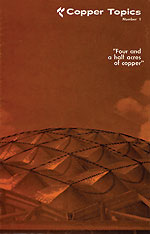 No. 1 - 1968
No. 1 - 1968
Adorning Cultural Landmarks
Mexico City's "Palace of the One Hundred Suns," a sports and cultural arena built for the 1968 Olympic Games, evokes the Aztec pyramids created some 1,500 years ago. Its crowning glory is a giant domed roof made from a series of 121 copper pyramids fashioned together. The massive roof glitters spectacularly in the sun; hence the arena's unusual nickname. Architect Felix Candela chose copper for its durability and natural beauty.
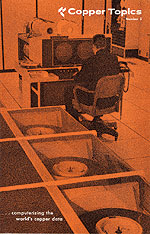 No. 2 - 1968
No. 2 - 1968
Innovative Automobile Electronics
Volkswagen and Pontiac unveil automobiles featuring innovative copper technology. A rear window de-icing system in the VW uses copper-coated electrical heating circuits powered by the car's battery. Nearly invisible thread-thin copper wires embedded in the Pontiac Grand Prix's windshield serve as the car's radio antenna.
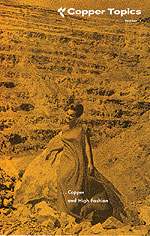 No. 3 - 1969
No. 3 - 1969
Affordable Exterior Cladding
Plywood panels laminated with a copper top-sheet make a bold design statement on Holiday Inn's prototype motel in Bridgeport, Conn. This new lightweight copper fascia system from Ardmore Products Inc. reduces material and installation costs, making copper more competitive as a material for building construction.
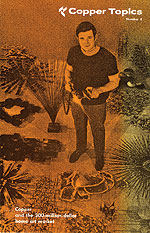 No. 4 - 1969
No. 4 - 1969
Artistic Home Decor
"Designed sculptures" made from copper, brass and bronze are popular in home décor. Department stores such as Lord & Taylor promote these decorative objects as upscale home furnishings for the middle class. Dave Grossman, one of the era's leading sculptors, describes his work as "art for the mass market, rather than serious, one-of-a-kind art."
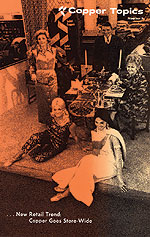 No. 5 - 1969
No. 5 - 1969
Enhancing Urban Landscapes
The First National Bank building in Chicago becomes the tallest bank building in the world. Its other great accomplishment is the extensive use of bronze for its sloping exterior walls - the building's trademark - and the bank's interior, which includes bronze check writing tables that weigh 400 pounds each.
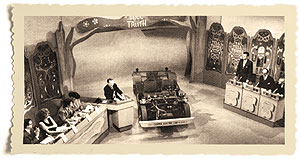 Some 20 million television viewers saw the CDA's first prototype copper electric car debut on the game show "To Tell the Truth."
Some 20 million television viewers saw the CDA's first prototype copper electric car debut on the game show "To Tell the Truth."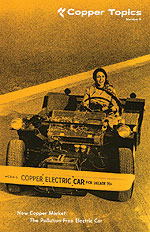 No. 6 - 1970
No. 6 - 1970
Emissions-Free Vehicle
A prototype copper electric car produced by the Copper Development Association debuts to widespread media attention, including a drive-on appearance on the popular Sixties game show "To Tell the Truth." This emissionfree vehicle has a top speed of 70 miles per hour and can travel up to 150 miles on a single electric charge.
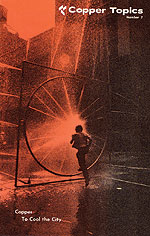 No. 7 - 1970
No. 7 - 1970
Keeping Kids Cool
Using only a fraction of the water lost by an open fire hydrant (a popular urban practice is opening fire hydrants to cool off in the summer), a series of giant, portable, copper water sprinklers keep New York City children cool in the summer heat. Designed from ordinary copper plumbing tube by New York artist Anita Margrill, the 10- foot-tall sprinklers are lightweight yet durable enough to stand-up to children's play and repeated use on the city streets.
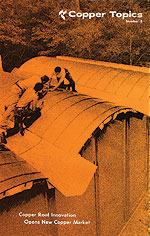 No. 8 - 1970
No. 8 - 1970
Copper "Tupperware" Parties
With its part-time sales force of housewives selling copper household products from their homes, the Coppercraft Guild in Taunton, Massachusetts, sees a 50-percent boost in sales. "No other material is rich enough for company, informal enough for family," says Angela Preuss, a Coppercraft sales manager.
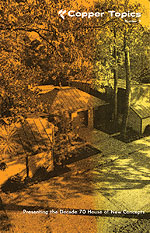 No. 9 - 1971
No. 9 - 1971
Beautiful Wall Coverings
"Chemetal" - a new, advanced cloth-backed copper and brass wall covering from Advanced Resin Products, is easily applied by skilled craftsmen and requires no special cleaning or care. Pure copper or brass sheets, 30 inches wide and up to 12 feet in length, feature unique one-of-a-kind patterns created by a chemical etching process.
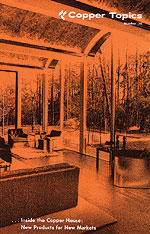 No. 10 - 1971
No. 10 - 1971
Lustrous Interior Design Options
Thousands of people tour the "Decade 70 House of New Concepts" at the National Home Builders Show in Houston, Texas. The showcase features dozens of interior design and building materials options made with copper, including a copper-clad vaulted ceiling, bronze flooring, a bronze room divider, a tri-columned bronze pedestal dining table, and copper laminate countertops and wall coverings.
 Angela Preuss, sales manager for the Coppercraft Guild, makers of copper household products such as chafing dishes and candlestick holders, holds aloft a 1970 sales goal for the company's part-time sales force, which sells copper products at parties held in their homes.
Angela Preuss, sales manager for the Coppercraft Guild, makers of copper household products such as chafing dishes and candlestick holders, holds aloft a 1970 sales goal for the company's part-time sales force, which sells copper products at parties held in their homes.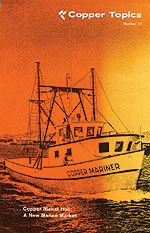 No. 11 - 1971
No. 11 - 1971
Antifouling Marine Applications
A prototype shrimp boat with a coppernickel hull lives up to its potential in the first two months of testing in the waters off Nicaragua. The 67-foot craft was built to demonstrate copper's unique ability to prevent barnacles and other marine life from fouling the ship's bottom. As a result, the Copper Mariner travels at 16 percent greater speed and with 22.5 percent less fuel consumption than similar vessels with conventional hulls.
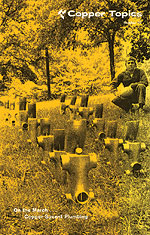 No. 12 - 1971
No. 12 - 1971
Life-Saving Sprinkler Systems
After a devastating fire kills 28 hotel guests, Tucson's Pioneer International Hotel rebuilds and installs the first "life-oriented" fire sprinkler system made entirely with copper tubing. The fast-reacting copper system was developed by the CDA and is hailed as a muchneeded and cost-effective improvement over conventional steel-pipe sprinklers, the latter being designed primarily to protect property, not human life.
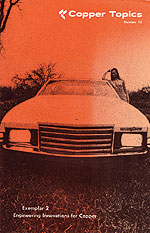 No. 13 - 1972
No. 13 - 1972
Futuristic Camper
Renowned auto designer Mario Revilli creates a new prototype vehicle, the Exemplar 2, for the Copper Development Association. This hightech auto is equipped with copper alloy brake discs, copper alloy brake lines, copper alloy trim and an innovative electro-hydraulic power system. With the push of a button, the system transforms the vehicle into a camper, with passenger seats that become beds and a roof that rises for additional headroom.
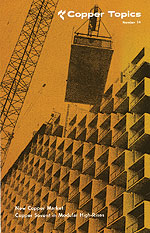 No. 14 - 1972
No. 14 - 1972
Pre-Plumbed Units Speed Construction
Seventy factory-built modular hotel rooms, complete with preinstalled copper plumbing and electrical systems, are shipped cross-country by rail and installed as part of a multi-story hotel addition near the new Walt Disney World resort in Orlando, Florida. The rooms, which come with finished balconies, painted ceilings, carpets and wall coverings in place, take only six days to assemble when they arrive.
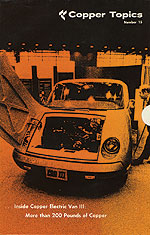 No. 15 - 1972
No. 15 - 1972
Electricpowered SUV
The first electric utility vehicle takes center stage at Chicago's Design Engineering Show. Named the Electric Van III, this is the third electric vehicle to be introduced by the Copper Development Association. A precursor to modern Sport Utility Vehicles, the electric van features a lightweight, highly aerodynamic body that reduces air drag for overall efficiency.
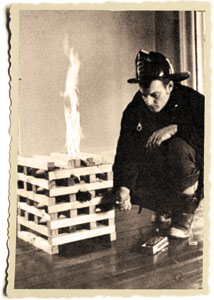 The CDA-developed "Life Safety System," an all-copper residential sprinkler system, is more economical to install than existing steel pipe systems that are designed for industrial use. The automatic copper fire sprinklers require a much smaller available water supply because residential fires develop more slowly than industrial fires.
The CDA-developed "Life Safety System," an all-copper residential sprinkler system, is more economical to install than existing steel pipe systems that are designed for industrial use. The automatic copper fire sprinklers require a much smaller available water supply because residential fires develop more slowly than industrial fires.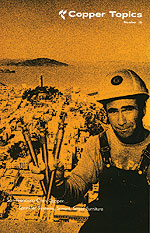 No. 16 - 1972
No. 16 - 1972
High Rise Fire Safety
San Francisco's tallest skyscraper, the 50- story Transamerica Building - dubbed "the Pyramid" by its creators - is outfitted with a new automatic fire sprinkler system using all-copper tubing. Mechanical and electrical engineers who install the system say they chose copper over screw-jointed pipe conductors because it is "lightweight, easier to cut (than steel), and its soldered joints are stronger in an earthquake situation."
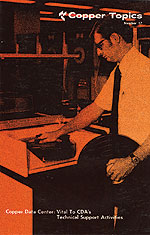 No. 17 - 1973
No. 17 - 1973
Informative Research Center
The computer-based Copper Data Center celebrates seven years of helping engineers throughout the country retrieve important technical data on copper, brass and bronze in a matter of minutes. This free service from CDA is located in Columbus, Ohio. The data center can be accessed remotely by decision-makers in the copper and metals industry worldwide via remote computer terminals in their offices.
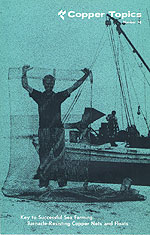 No. 18 - 1973
No. 18 - 1973
Superior Sea Farming
Sea farmers at Marifarms Inc. in Panama City, Florida, discover copper's antifouling properties and switch to copper floats in place of the foamplastic floats they were using. Plastic floats are quickly covered with barnacles, weighing them down and endangering the shrimp farmers' business because they allow the shrimp "crops" to escape.
 No. 19 - 1973
No. 19 - 1973
"Humanizing" Mass Transportation
Bronze architectural elements are used throughout Washington, D.C.'s new Metro Rail System to create a sense of visual warmth, softness and human scale. Handrails, doors and hardware, information kiosks and 12-foothigh pylons marking the entrances to the new rapid rail system are executed in bronze to entice people to leave their cars at home and take the new mass transportation system into the city.
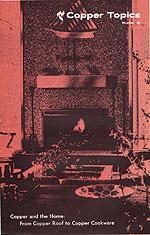 No. 20 - 1973
No. 20 - 1973
Durable Commercial Roofing
A recreational complex in New Hampshire sports a new highstrength, light-gauge 12-ounce copper roofing sheet designated "Tough 12" by CDA. Using less copper than 16- ounce standard copper sheet, it proves to be more affordable yet equally durable. Copper roofing, known for its quality and durability, typically remains trouble-free longer and outlasts other roofing materials.
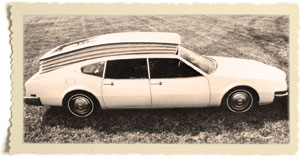 CDA's 1972 Exemplar 2 prototype car features a roof that extends (as shown) for extra headroom while camping.
CDA's 1972 Exemplar 2 prototype car features a roof that extends (as shown) for extra headroom while camping.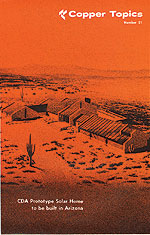 No. 21 - 1974
No. 21 - 1974
Forward-Looking Technology
The first publicly announced commercial electric vehicle test in the USA gets underway in Birmingham, Michigan, using CDA's Copper Electric Van IIIB. This two-year test by the City of Birmingham will pit electric- and gasolinepowered vehicles against each other in side-by-side performance comparisons.
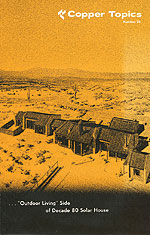 No.22 - 1974
No.22 - 1974
Enabling Solar Power
CDA breaks ground on the first true solarpowered house using commercially available technology. A solarcollector roof system employs copper plumbing tube and copper sheet metal to capture energy from the sun. This "free" power provides up to 75 percent of the home's energy for cooling and 100 percent of its energy for space heating.
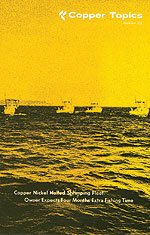 No. 23 - 1974
No. 23 - 1974
Faster Fishing Fleets
The world's first barnacle- resistant fishing fleet launches from Mexico's West Coast, three years after CDA put its prototype copper- nickel hulled shrimp trawler, the Copper Mariner, into service. Despite continuous use in Nicaraguan waters, the Mariner showed no harmful marine growth and required no hull maintenance for a savings of up to $10,000 annually.
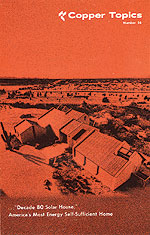 No. 24 - 1975
No. 24 - 1975
Promoting New Markets
With its goal of creating new markets for the copper, brass and bronze industries, CDA completes construction of its "Decade 80 Solar House." In addition to a copper solar energy collector roof system, the home features a copper automatic fire sprinkler system, solid copper and brass wallpaper, a bronze window and door system, and more.
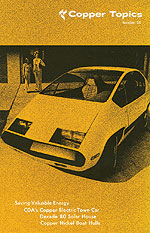 No. 25 - 1975
No. 25 - 1975
Energy Efficient Electric Car
A Copper Electric Town Car is the CDA's fifth in a series of prototype electric cars to hit the streets. Designed for running errands and quick trips in stop-andgo traffic, the twoseater features an aerodynamic shape and roomy hatchback. It has a 75-mile range on a single charge in city driving. Energy costs are estimated between $0.02 and $0.03 a mile.
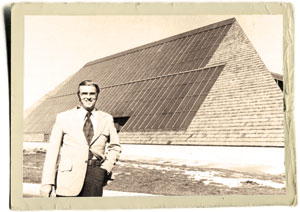 The nation's first solarpowered church is the Center of Hope Church in Denver. Shown is Pastor Al Haan standing in front of more than 80 all-copper solar collectors that provide space heating and domestic hot water for the structure.
The nation's first solarpowered church is the Center of Hope Church in Denver. Shown is Pastor Al Haan standing in front of more than 80 all-copper solar collectors that provide space heating and domestic hot water for the structure.Also in this Issue:
- Four Decades of Innovation: Issues 1 - 25
- Four Decades of Innovation: Issues 26 - 60
- Four Decades of Innovation: Issues 61 - 99
- Copper Shines on Prime Time
- The History of Copper
- The Future of Copper
